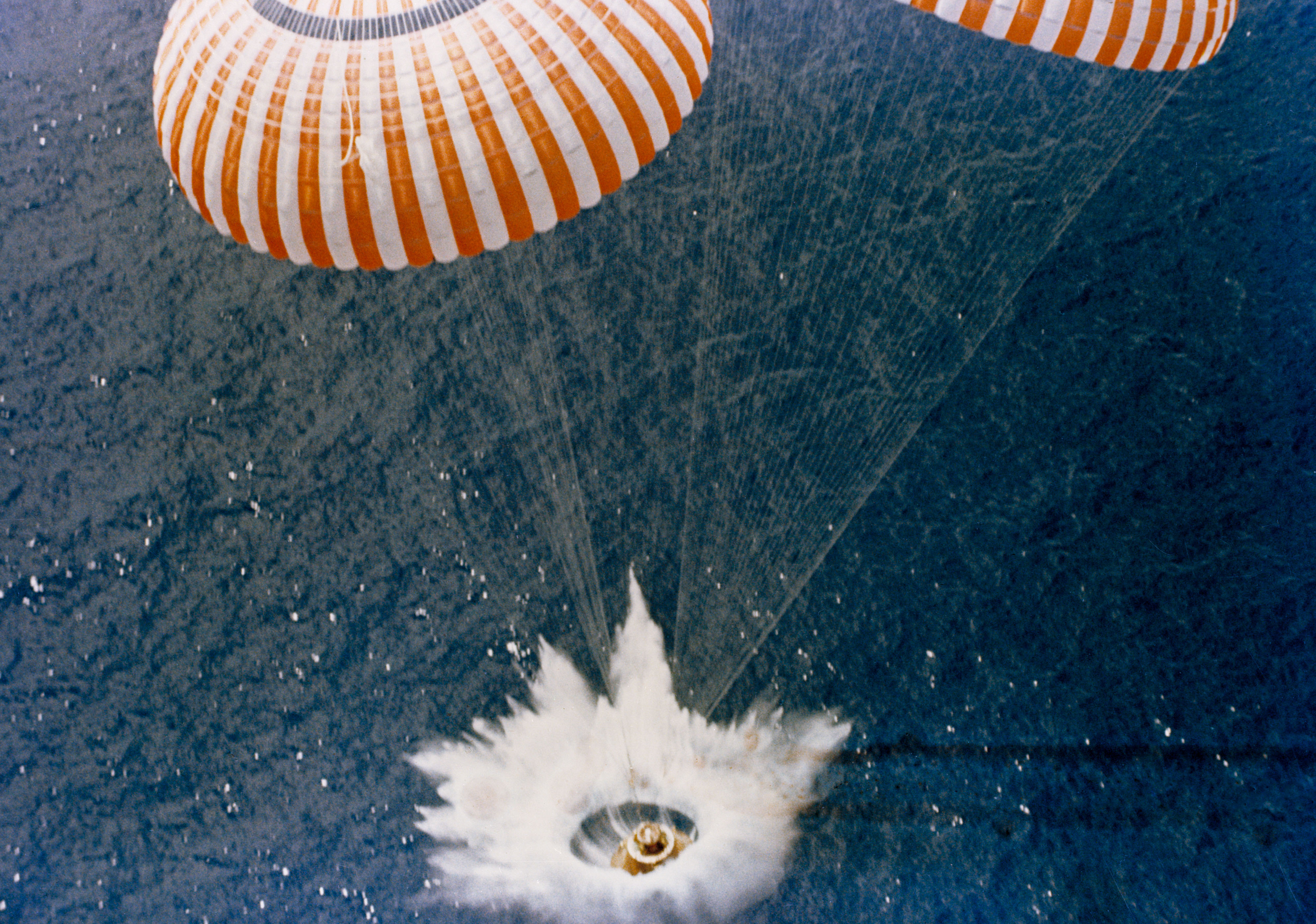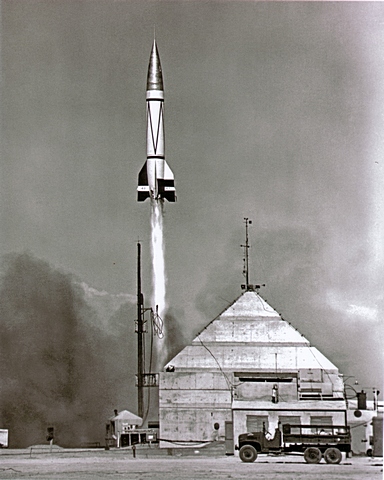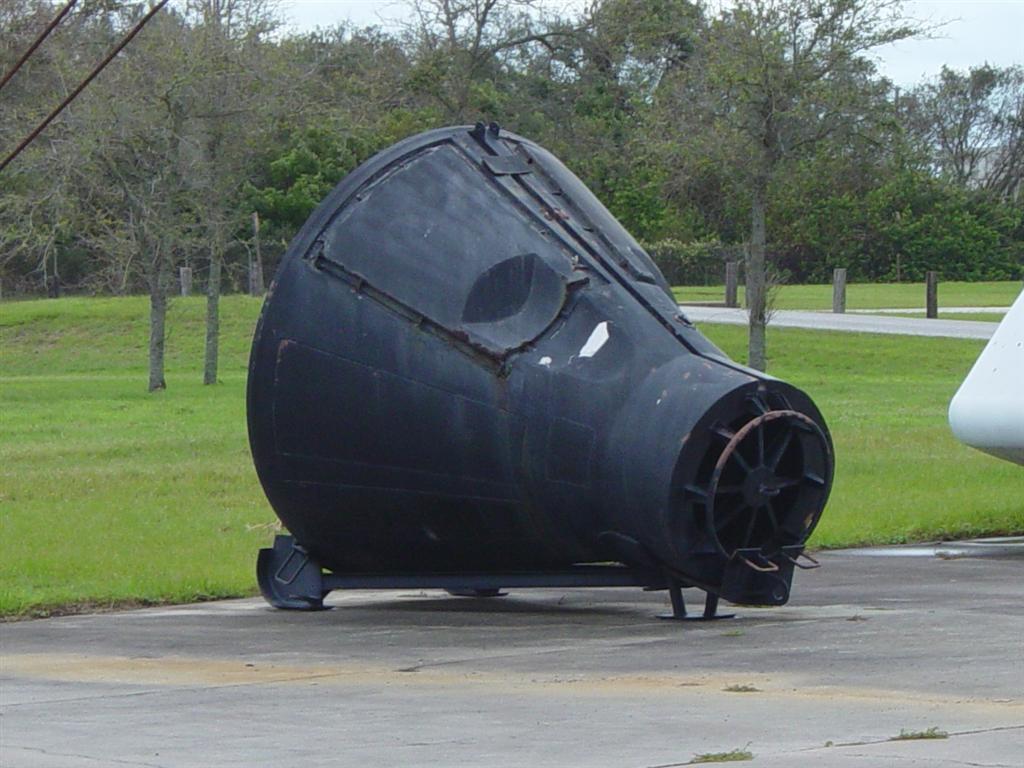|
Little Joe 2
The Little Joe 2 was a test of the Mercury space capsule, carrying the rhesus monkey Sam (''Macaca mulatta'') close to the edge of space. He was sent to test the space equipment and the adverse effects of space on humans. The flight was launched December 4, 1959, at 11:15 a.m. ET from Wallops Island, Virginia, United States. Little Joe 2 flew to an altitude of 55 miles (88 km). It was recovered with the monkey intact and alive in the Atlantic Ocean by the USS ''Borie''. Sam was one of a series of monkeys in space. Sam, from the School of Aviation Medicine in San Antonio, Texas, received his name as an acronym of the facility. Sam experienced up to 12Gs and three minutes of weightlessness. The flight time was 11 minutes, 6 seconds, with a payload of 1,007 kg. The boilerplate Mercury spacecraft used in the Little Joe 2 mission is currently displayed at Airpower Park and Museum, Hampton, Virginia. See also * Little Joe (rocket) * Miss Sam, NASA Project Mercury ... [...More Info...] [...Related Items...] OR: [Wikipedia] [Google] [Baidu] |
Little Joe (rocket)
Little Joe was a solid-fueled booster rocket used by NASA for eight launches from 1959 to 1960 from Wallops Island, Virginia to test the launch escape system and heat shield for Project Mercury capsules, as well as the name given to the test program using the booster. The first rocket designed solely for crewed spacecraft qualifications, Little Joe was also one of the pioneer operational launch vehicles using the rocket cluster principle. The Little Joe name has been attributed to Maxime Faget at NASA's Langley Research Center in Hampton, Virginia. He based the name on four large fins which reminded him of a slang term for a roll of four in craps. A successor, Little Joe II, was used for flight testing of the Apollo launch escape system from 1963 to 1966. Background When NASA needed a booster for Project Mercury, the agency found that the Atlas rockets would cost approximately US$2.5 million each and that even the Redstone would cost about $1 million per launch. The manage ... [...More Info...] [...Related Items...] OR: [Wikipedia] [Google] [Baidu] |
NASA
The National Aeronautics and Space Administration (NASA ) is an independent agency of the US federal government responsible for the civil space program, aeronautics research, and space research. NASA was established in 1958, succeeding the National Advisory Committee for Aeronautics (NACA), to give the U.S. space development effort a distinctly civilian orientation, emphasizing peaceful applications in space science. NASA has since led most American space exploration, including Project Mercury, Project Gemini, the 1968-1972 Apollo Moon landing missions, the Skylab space station, and the Space Shuttle. NASA supports the International Space Station and oversees the development of the Orion spacecraft and the Space Launch System for the crewed lunar Artemis program, Commercial Crew spacecraft, and the planned Lunar Gateway space station. The agency is also responsible for the Launch Services Program, which provides oversight of launch operations and countdown management f ... [...More Info...] [...Related Items...] OR: [Wikipedia] [Google] [Baidu] |
Virginia
Virginia, officially the Commonwealth of Virginia, is a state in the Mid-Atlantic and Southeastern regions of the United States, between the Atlantic Coast and the Appalachian Mountains. The geography and climate of the Commonwealth are shaped by the Blue Ridge Mountains and the Chesapeake Bay, which provide habitat for much of its flora and fauna. The capital of the Commonwealth is Richmond; Virginia Beach is the most-populous city, and Fairfax County is the most-populous political subdivision. The Commonwealth's population was over 8.65million, with 36% of them living in the Baltimore–Washington metropolitan area. The area's history begins with several indigenous groups, including the Powhatan. In 1607, the London Company established the Colony of Virginia as the first permanent English colony in the New World. Virginia's state nickname, the Old Dominion, is a reference to this status. Slave labor and land acquired from displaced native tribes fueled the ... [...More Info...] [...Related Items...] OR: [Wikipedia] [Google] [Baidu] |
Splashdown
Splashdown is the method of landing a spacecraft by parachute in a body of water. It was used by crewed American space capsules prior to the Space Shuttle program, by SpaceX Dragon and Dragon 2 capsules and by NASA's Orion Multipurpose Crew Vehicle. It is also possible for the Russian Soyuz spacecraft to land in water, though this is only a contingency. The only example of an unintentional crewed splashdown in Soviet history is the Soyuz 23 landing. As the name suggests, the capsule parachutes into an ocean or other large body of water. The properties of water cushion the spacecraft enough that there is no need for a braking rocket to slow the final descent as is the case with Russian and Chinese crewed space capsules (while Shenzhou designed a raft and balanced capsule in case of splashdown), which return to Earth over land. The American practice came in part because American launch sites are on the coastline and launch primarily over water. Russian launch sites are far i ... [...More Info...] [...Related Items...] OR: [Wikipedia] [Google] [Baidu] |
Albert II (monkey)
Albert II, a male rhesus macaque (''Macaca mulatta''), was the first primate and first mammal in space. He flew from Holloman Air Force Base in New Mexico, United States, to an altitude of 83 miles (134 km) aboard a U.S. V-2 sounding rocket on June 14, 1949. Albert died upon reentry after a parachute failure caused Albert's capsule to strike the ground at high speed. Albert's respiratory and cardiological data were recorded up to the moment of impact. Albert II's flight, run by the Alamogordo Guided Missile Test Base and organized with the help of Holloman Air Force Base, followed the likely preflight death of Albert I before a high mesospheric flight aboard a V-2 rocket on June 11, 1948. The capsule was redesigned in-between flights to enlarge the cramped quarters experienced by Albert I. See also * Monkeys and apes in space * Animals in space * Alice King Chatham, who designed Albert II's oxygen mask and harness * Ham, a chimpanzee, the first great ape in space (January 31, 1 ... [...More Info...] [...Related Items...] OR: [Wikipedia] [Google] [Baidu] |
Miss Sam
The Little Joe 1B was a launch escape system test of the Mercury spacecraft, conducted as part of the U.S. Mercury program. The mission also carried a female rhesus monkey (''Macaca mulatta'') named Miss Sam in the Mercury spacecraft. The mission was launched January 21, 1960, from Wallops Island, Virginia. The Little Joe 1B flew to an apogee of 9.3 statute miles (15.0 km) and a range of 11.7 miles (18.9 km) out to sea. Miss Sam survived the 8 minute 35 second flight in good condition. The spacecraft was recovered by a Marine helicopter and returned to Wallops Island within about 45 minutes. Miss Sam was one of many monkeys used in space travel research. Gallery See also * Little Joe * Sam (monkey), NASA Project Mercury rhesus monkey * Monkeys and apes in space * List of individual monkeys References External links NASA Project Mercury Mission LJ-1Bat ''Kennedy Space Science and Technology'' website at ''Encyclopedia Astronautica The ''Encyclopedia Astronauti ... [...More Info...] [...Related Items...] OR: [Wikipedia] [Google] [Baidu] |
Air Power Park
The Air Power Park is an outdoor, roadside museum in Hampton, Virginia which recognizes Hampton's role in America's early space exploration and aircraft testing. The outdoor park is open year-round, seven days a week from sunrise to sunset. Several vintage aircraft and experimental space launch vehicles from the 1950s and 1960s are displayed out of doors. The park is on a plot and includes a children's playground. The indoor museum at the center of the park was reopened after a 2011 renovation (with hours more limited than the outdoor part of the park). There are eight themed rooms containing over 325 models of aircraft, space craft, and nautical vessels representing all the U.S. branches of service as well as various model craft from other nations. The park also has a time capsule Indoor museum *NASA Room *United States Air Force Aviation Room- Including items highlighting nearby Langley Air Force Base's contribution to the USAF. *General Aviation Room *Library *Cold War Era ... [...More Info...] [...Related Items...] OR: [Wikipedia] [Google] [Baidu] |
Boilerplate (spaceflight)
A boilerplate spacecraft, also known as a mass simulator, is a nonfunctional craft or payload that is used to test various configurations and basic size, load, and handling characteristics of rocket launch vehicles. It is far less expensive to build multiple, full-scale, non-functional boilerplate spacecraft than it is to develop the full system (design, test, redesign, and launch). In this way, boilerplate spacecraft allow components and aspects of cutting-edge aerospace projects to be tested while detailed contracts for the final project are being negotiated. These tests may be used to develop procedures for mating a spacecraft to its launch vehicle, emergency access and egress, maintenance support activities, and various transportation processes. Boilerplate spacecraft are most commonly used to test crewed spacecraft; for example, in the early 1960s, NASA performed many tests using boilerplate Apollo spacecraft atop Saturn I rockets, and Mercury spacecraft atop Atlas rocke ... [...More Info...] [...Related Items...] OR: [Wikipedia] [Google] [Baidu] |
Ars Technica
''Ars Technica'' is a website covering news and opinions in technology, science, politics, and society, created by Ken Fisher and Jon Stokes in 1998. It publishes news, reviews, and guides on issues such as computer hardware and software, science, technology policy, and video games. ''Ars Technica'' was privately owned until May 2008, when it was sold to Condé Nast Digital, the online division of Condé Nast Publications. Condé Nast purchased the site, along with two others, for $25 million and added it to the company's ''Wired'' Digital group, which also includes ''Wired'' and, formerly, Reddit. The staff mostly works from home and has offices in Boston, Chicago, London, New York City, and San Francisco. The operations of ''Ars Technica'' are funded primarily by advertising, and it has offered a paid subscription service since 2001. History Ken Fisher, who serves as the website's current editor-in-chief, and Jon Stokes created ''Ars Technica'' in 1998. Its purpose was ... [...More Info...] [...Related Items...] OR: [Wikipedia] [Google] [Baidu] |
Monkeys In Space
Before humans went into space in the 1960s, several other animals were launched into space, including numerous other primates, so that scientists could investigate the biological effects of spaceflight. The United States launched flights containing primate passengers primarily between 1948 and 1961 with one flight in 1969 and one in 1985. France launched two monkey-carrying flights in 1967. The Soviet Union and Russia launched monkeys between 1983 and 1996. Most primates were anesthetized before lift-off. Overall, thirty-two non-human primates flew in the space program; none flew more than once. Numerous backup primates also went through the programs but never flew. Monkeys and non-human apes from several species were used, including rhesus macaque, crab-eating macaque, squirrel monkeys, pig-tailed macaques, and chimpanzees. United States The first primate launched into subspace was Albert, a rhesus macaque, who on June 11, 1948, rode a rocket flight to over in Earth's atmos ... [...More Info...] [...Related Items...] OR: [Wikipedia] [Google] [Baidu] |
USS Borie (DD-704)
USS ''Borie'' (DD-704), an , was the second ship of the United States Navy to be named for Adolph E. Borie, Secretary of the Navy under President Ulysses S. Grant. Construction ''Borie'' (DD-704) was launched on 4 July 1944 by Federal Shipbuilding and Dry Dock Co., Kearny, New Jersey sponsored by Mrs Albert Nalle (née Patty Neill Borie, great-grandniece of Adolph E. Borie); and commissioned on 21 September 1944. Service history World War II ''Borie'' joined the Pacific Fleet, arriving at Pearl Harbor 4 January 1945. She took part in the Battle of Iwo Jima, both the bombardment (24 January) and invasion (19–23 February). After joining Task Force 58, she participated in the Tokyo raids (16–17 and 25 February), Okinawa raid (1 March), and the raids in support of the occupation of Okinawa (17 March–14 May). From 9 July to 9 August, she served with Task Force 38 in its raids on the Japanese home islands. On 9 August, four ''kamikaze''s attempted to crash into ''Borie ... [...More Info...] [...Related Items...] OR: [Wikipedia] [Google] [Baidu] |
Wallops Island
Wallops Island is a island in Accomack County, Virginia, part of the Virginia Barrier Islands that stretch along the eastern seaboard of the United States of America. It is just south of Chincoteague Island, a popular tourist destination. Wallops Island proper, originally known as Kegotank Island, was granted to John Wallop by the Crown on April 29, 1692. Ownership was divided through the years, until the Commonwealth of Virginia seized the property in 1876 and 1877 in lieu of unpaid taxes. From 1877, ownership was again divided and subdivided until 1889, when it was held by various trustees for the Wallops Island Club. The Club was incorporated and assumed ownership in 1933 as the Wallops Island Association, Inc. Association members and their families spent the summers fishing and swimming on the island. The Association grazed sheep, cattle, and ponies on the area until the mid-1940s. In 1947, the U.S. Navy began using the upper two-thirds of the island on a lease-rental bas ... [...More Info...] [...Related Items...] OR: [Wikipedia] [Google] [Baidu] |






.jpg)